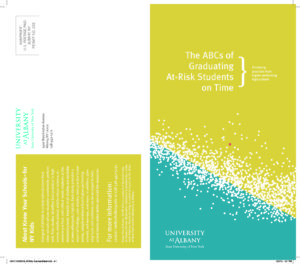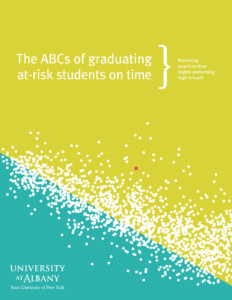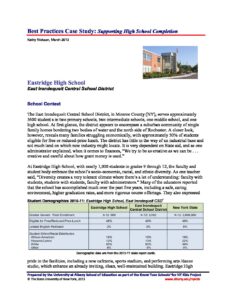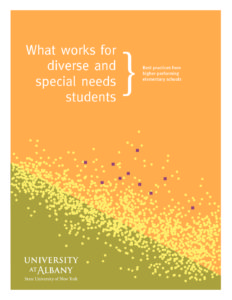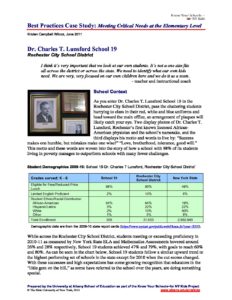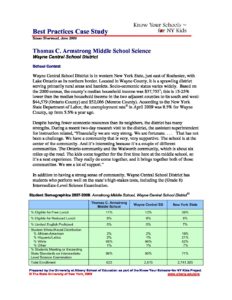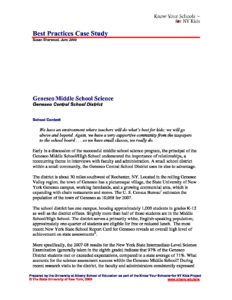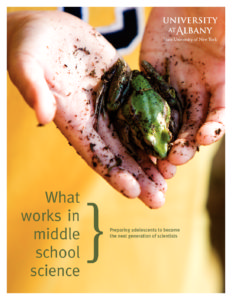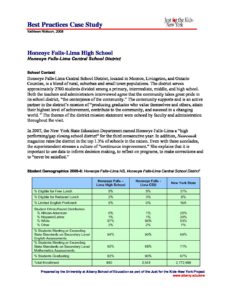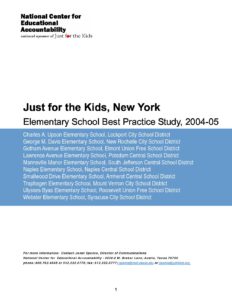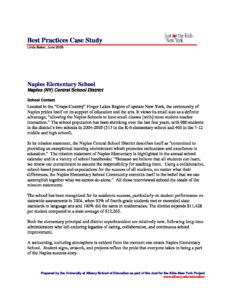Region: Finger Lakes
Presentation at the American Anthropological Association’s Annual Conference, November 2019
This presentation explores the relationship between teacher and student agency at odds-beating secondary schools. We find that teachers, when offered opportunities to act as agents, tend to offer similar opportunities to their students similarly. This research further suggests that affordances for teachers to assert agency can mitigate the constraining effects of state accountability system compliance-oriented practices.
An investigation of 13 high schools; eight of these schools had consistently higher than predicted graduation rates among at least two critical needs groups and five consistently achieved average graduation rates, given their student demographics.
In 2012-13, research teams investigated 13 high schools; eight of these schools had consistently higher than predicted graduation rates among at least two critical needs groups and five consistently achieved average graduation rates, given their student demographics. Schools were selected based on the four-year graduation rates for cohorts of 2004, 2005, and 2006, as reported on their state report cards in 2009-11. Researchers used site-based interviews of teachers and administrators, as well as analyses of supportive documentation, to determine differences in practices between higher- and average-performing schools in the sample.
An investigation of 13 high schools; eight of these schools had consistently higher than predicted graduation rates among at least two critical needs groups and five consistently achieved average graduation rates, given their student demographics.
In 2012-13, research teams investigated 13 high schools; eight of these schools had consistently higher than predicted graduation rates among at least two critical needs groups and five consistently achieved average graduation rates, given their student demographics. Schools were selected based on the four-year graduation rates for cohorts of 2004, 2005, and 2006, as reported on their state report cards in 2009-11. Researchers used site-based interviews of teachers and administrators, as well as analyses of supportive documentation, to determine differences in practices between higher- and average-performing schools in the sample.
A case study report from an investigation of 13 high schools; eight of these schools had consistently higher than predicted graduation rates among at least two critical needs groups and five consistently achieved average graduation rates, given their student demographics.
This case study is one of a series of studies conducted by Know Your Schools~for NY Kids since 2005. In 2012-13, research teams investigated 13 high schools; eight of these schools had consistently higher than predicted graduation rates among at least two critical needs groups and five consistently achieved average graduation rates, given their student demographics. Schools were selected based on the four-year graduation rates for cohorts of 2004, 2005, and 2006, as reported on their state report cards in 2009-11. Researchers used site-based interviews of teachers and administrators, as well as analyses of supportive documentation, to determine differences in practices between higher- and average-performing schools in the sample.
For the study of critical needs elementary schools, conducted during the 2010-11 school year, research teams investigated ten consistently higher-performing and five consistently average-performing elementary schools.
This case study is one of a series of studies conducted by Know Your Schools~for NY Kids since 2005. For the study of critical needs elementary schools, conducted during the 2010-11 school year, research teams investigated ten consistently higher-performing and five consistently average-performing elementary schools. Schools were selected based on the performance of critical needs subgroups – African American, Hispanic, English language learners, and special education students, and students living in poverty as measured by eligibility for free or reduced-price lunch – on New York State Assessments of English Language Arts and Mathematics for grades 3 through 4, 5, or 6 in 2007, 2008, and 2009.
This case study is part of an investigation of critical needs elementary schools during the 2010-11 school year.
This case study is one of a series of studies conducted by Know Your Schools~for NY Kids since 2005. For the study of critical needs elementary schools, conducted during the 2010-11 school year, research teams investigated ten consistently higher-performing and five consistently average-performing elementary schools. Schools were selected based on the performance of critical needs subgroups – African American, Hispanic, English language learners, and special education students, and students living in poverty as measured by eligibility for free or reduced-price lunch – on New York State Assessments of English Language Arts and Mathematics for grades 3 through 4, 5, or 6 in 2007, 2008, and 2009.
This case study is part of an investigation of middle school science conducted in the 2008-2009 school year.
This case study was conducted in spring 2009 as one of a series of studies conducted by Just for the Kids~New York since 2005. For the study of middle school science, research teams investigated seven consistently higher-performing and three average-performing schools based on student performance on the New York State Intermediate-Level Science Examination in 2006, 2007, and 2008. Researchers used site-based interviews of teachers and administrators, as well as classroom observations and analyses of supportive documentations, to determine differences in practices between higher- and average-performing schools in the sample.
This is a case study investigating middle school science conducted in the 2008-2009 school year.
This case study was conducted in spring 2009 as one of a series of studies conducted by Just for the Kids~New York since 2005. For the study of middle school science, research teams investigated seven consistently higher-performing and three average-performing schools based on student performance on the New York State Intermediate-Level Science Examination in 2006, 2007, and 2008. Researchers used site-based interviews of teachers and administrators, as well as classroom observations and analyses of supportive documentations, to determine differences in practices between higher- and average-performing schools in the sample.
This case study is part of an investigation of middle school science conducted in the 2008-2009 school year.
This case study was conducted in spring 2009 as one of a series of studies conducted by Just for the Kids~New York since 2005. For the study of middle school science, research teams investigated seven consistently higher-performing and three average-performing schools based on student performance on the New York State Intermediate-Level Science Examination in 2006, 2007, and 2008. Researchers used site-based interviews of teachers and administrators, as well as classroom observations and analyses of supportive documentations, to determine differences in practices between higher- and average-performing schools in the sample.
This is a case study investigating middle school science conducted in the 2008-2009 school year.
This case study was conducted in spring 2009 as one of a series of studies conducted by Just for the Kids~New York since 2005. For the study of middle school science, research teams investigated seven consistently higher-performing and three average-performing schools based on student performance on the New York State Intermediate-Level Science Examination in 2006, 2007, and 2008. Researchers used site-based interviews of teachers and administrators, as well as classroom observations and analyses of supportive documentations, to determine differences in practices between higher- and average-performing schools in the sample.
This is an investigation of high schools conducted during the 2007-08 school year.
This case study is one of 10 produced as part of a larger study of high schools conducted during the 2007-08 school year. Research teams investigated 10 consistently higher-performing and five average-performing high schools based on student performance on New York State Assessments of English, mathematics, science, and history. Researchers used site-based interviews of teachers and administrators, as well as analyses of supportive documentation, to determine differences in practices between higher-and average-performing schools in the sample.
This case study is one of 10 produced as part of a larger study of high schools conducted during the 2007-08 school year.
This case study is one of 10 produced as part of a larger study of high schools conducted during the 2007-08 school year. Research teams investigated 10 consistently higher-performing and five average-performing high schools based on student performance on New York State Assessments of English, mathematics, science, and history. Researchers used site-based interviews of teachers and administrators, as well as analyses of supportive documentation, to determine differences in practices between higher-and average-performing schools in the sample.
This is an investigation of high schools conducted during the 2007-08 school year.
This case study is one of 10 produced as part of a larger study of high schools conducted during the 2007-08 school year. Research teams investigated 10 consistently higher-performing and five average-performing high schools based on student performance on New York State Assessments of English, mathematics, science, and history. Researchers used site-based interviews of teachers and administrators, as well as analyses of supportive documentation, to determine differences in practices between higher-and average-performing schools in the sample.
This study was conducted in the 2004-2005 school year of average and higher performing elementary schools to determine the differences in practices.
Conducted in the 2004-2005 school year, research teams investigated 10 consistently higher performing and five average performing elementary schools to determine the differences in practices between higher and average performing elementary schools. Schools were identified through an in-depth analysis of academic achievement. Researchers used site-based interviews and observations, as well as the analysis of supportive documentation, to investigate the practices of each of the 15 schools in the study. District-, school-, and classroom-level practices were studied in the five themes of NCEA’s Best Practice Framework: Curriculum and Academic Goals; Staff Selection, Leadership, and Capacity Building; Instructional Programs, Practices, and Arrangements; Monitoring: Compilation, Analysis, and Use of Data; and Recognition, Intervention, and Adjustment.
This study was conducted in the 2004-2005 school year of average and higher performing elementary schools to determine the differences in practices.
Conducted in the 2004-2005 school year, research teams investigated 10 consistently higher performing and five average performing elementary schools to determine the differences in practices between higher and average performing elementary schools. Schools were identified through an in-depth analysis of academic achievement. Researchers used site-based interviews and observations, as well as the analysis of supportive documentation, to investigate the practices of each of the 15 schools in the study. District-, school-, and classroom-level practices were studied in the five themes of NCEA’s Best Practice Framework: Curriculum and Academic Goals; Staff Selection, Leadership, and Capacity Building; Instructional Programs, Practices, and Arrangements; Monitoring: Compilation, Analysis, and Use of Data; and Recognition, Intervention, and Adjustment.
This case study is part of a larger study conducted in the 2004-2005 school year of average and higher performing elementary schools to determine the differences in practices.
Conducted in the 2004-2005 school year, research teams investigated 10 consistently higher performing and five average performing elementary schools to determine the differences in practices between higher and average performing elementary schools. Schools were identified through an in-depth analysis of academic achievement. Researchers used site-based interviews and observations, as well as the analysis of supportive documentation, to investigate the practices of each of the 15 schools in the study. District-, school-, and classroom-level practices were studied in the five themes of NCEA’s Best Practice Framework: Curriculum and Academic Goals; Staff Selection, Leadership, and Capacity Building; Instructional Programs, Practices, and Arrangements; Monitoring: Compilation, Analysis, and Use of Data; and Recognition, Intervention, and Adjustment.


